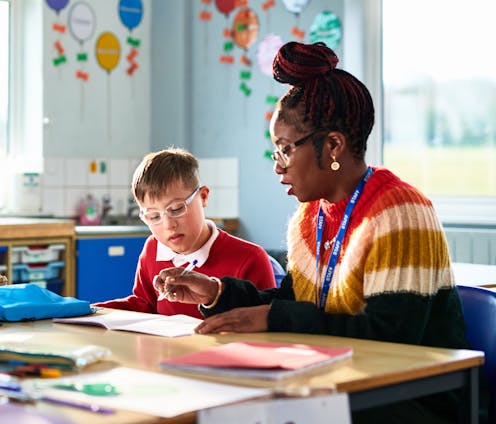
A growing number of students in public schools – right now, about 15% of them – are eligible for special education services. These services include specially designed instruction for students with autism, learning or physical disabilities, or traumatic brain injuries. But going into the current school year, more than half of U.S. public schools anticipate being short-staffed in special education. Dr. Kimber Wilkerson, a professor of special education and department chair at the University of Wisconsin-Madison, explains why there’s a shortage and what needs to be done to close the gap.
The Conversation has collaborated with SciLine to bring you highlights from the discussion, which have been edited for brevity and clarity.
Which students receive special education services?
Kimber Wilkerson: Students with a disability label receive special education services. They need these additional services and sometimes instruction in school so they can access the curriculum and thrive like their peers.
What is happening with staffing for special education?
Wilkerson: Since special education became a thing in the ’70s, there have always been challenges in filling all the special education positions.
In the past 10 years preceding the COVID-19 pandemic, those challenges started to increase. There were more open positions in special education at the beginning of each school year than in previous decades. In the 2023-24 school year, 42 states plus the District of Columbia reported teacher shortages in special education.
What is causing these shortages?
Wilkerson: One, there are fewer young people choosing teaching as a major in college and as a profession. And special education is affected by these lower rates more than other forms of education.
Also, there’s more attrition – people leaving their teaching job sooner than you might expect – not because they’re retiring, but because they are tired of the job.
They want to do something different. They want to go back to school. Sometimes it’s life circumstances, but the number of people leaving the job before retirement age has increased. And in our state, Wisconsin, about 35% of all educators leave the field before they hit their fifth year.
That number is even higher for special educators. About half of special educators are out of the profession within five years.
Why do special education teachers leave the profession?
Wilkerson: There’s not a national study that speaks to that reason. There are some localized studies, and people report things like too much paperwork or too many administrative tasks associated with the job. Sometimes they report the students’ behavioral challenges. Sometimes it’s a feeling of isolation, or a lack of support from the school.
How are students with disabilities affected when their school does not have enough special educators?
Wilkerson: In a school that’s one special educator short, the other special educators have to take over that caseload. Instead of having 12 students on their caseload, maybe now they have 20. So, the amount of individual attention given to each student with a disability decreases.
Also, when teachers with experience leave the profession, they leave behind a less experienced group of teachers. This means the students are losing out on the benefit of those years of wisdom and experience.
What are some strategies to recruit and retain more special education teachers?
Wilkerson: There’s a range of strategies that different universities, states and school districts have taken, like residency programs.
In these programs, the person who is learning to be a teacher, and who is referred to as a teaching resident, works alongside a mentor teacher for an entire year in a school, and they get paid to do so. They’re not the teacher of record, but they’re learning and getting paid, and they’re in that school community.
Can you tell us about your recent study on supporting new special education teachers?
Wilkerson: One thing that made a big difference is when the teachers in our study, which is now under review, had access to a mentor and a group of their peers. We called this facilitated peer-to-peer group of teachers a “community of practice.” Every other week, on Zoom, we’d get these new special education teachers from different school districts together, along with experienced teachers. And they would do some sort of work on problems, bringing in the things that were challenging, and work on possible solutions as a group.
We also used Zoom to do one-on-one mentoring. And what people liked about it was that they could talk to someone who wasn’t right in their building and right in their district who they could be open and vulnerable with.
Sometimes, special educators can be isolated because they’re not necessarily a part of a grade-level team. They work with kids across a lot of classrooms. This gave them an opportunity to have their own kind of community, and that made a difference.
We also surveyed their level of burnout and how good they felt about the job they did. And then we surveyed special education teachers who weren’t participating in our community of practice.
At the end of the year, those people who had that mentoring and the community of practice felt less burnt out, and they also felt more effective in the area of classroom management. And that’s critical, because burnout is one of the primary reasons people leave the profession.
So if we can make people feel like they’re better equipped to handle this challenging position, then that’s one strategy to increase the number of people wanting to stay in their job year after year.
Watch the full interview to hear more.
SciLine is a free service based at the American Association for the Advancement of Science, a nonprofit that helps journalists include scientific evidence and experts in their news stories.
Kimber Wilkerson receives funding from the U.S. Department of Education's Institute of Education Sciences and the Office of Elementary and Secondary Education.
This article was originally published on The Conversation. Read the original article.







